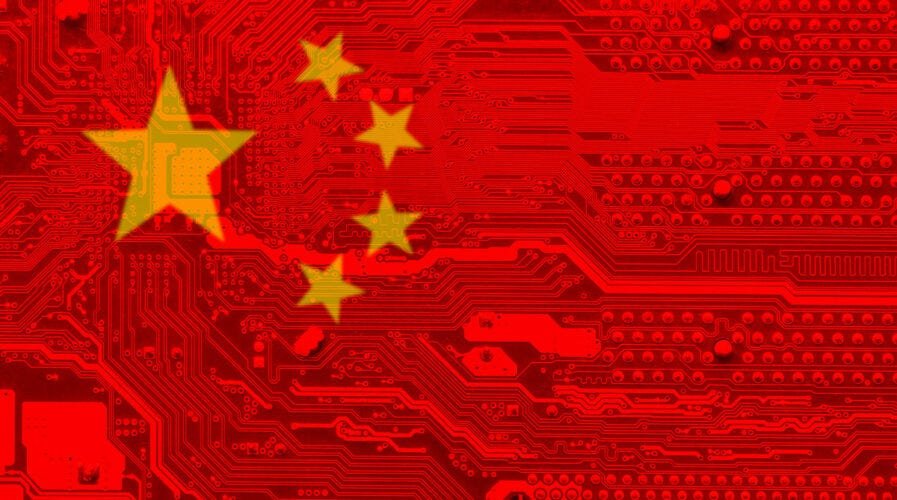The AI Sector in China. Much Smaller Than the US, Similar in Size to the UK.
Introduction
The UK is preparing to host the first global AI summit, but it’s unclear if China will attend or be invited. This is partly due to the fact that there is an AI arms race going on between the West (especially the United States) and China, and we are only in the early stages.
There are many ways to measure this technological race and the size of the respective AI sectors. Leading publications have provided some data, for example, a Nikkei study argued that China is far surpassing the U.S. in both quantity and quality of AI-related papers, with Tencent, Alibaba and Huawei among the top 10 companies producing AI research. China also seems to lead in AI patent filings, according to the World Intellectual Property Organization (WIPO) and several papers.
That said, the United States leads in terms of investment, and we know that US firms invested billions into the Chinese AI sector (before restrictions were imposed). Below is some data published by Bloomberg recently:
The US also kickstarted the Generative AI revolution, a fundamental technological shift. The success of ChatGPT accelerated the ongoing race for AI supremacy not only among the tech giants but also between countries. China recently published new rules for generative AI, becoming one of the first countries in the world to regulate this new technology.
It’s an open race that will continue over the coming years across many dimensions. Some argue that China will win because of its talent, growing technological skill and innovation, and national investment in science and technology. Others point out that while China has caught up with impressive speed, the conditions that allowed it to do so will likely also prevent it from taking a meaningful lead in the AI race.
Unfortunately in this debate, there is limited data about the AI sector in China beyond the tech giants and the data on academic publications and patents. In this article, we aim to contribute to the debate by providing data and evidence about the companies in the AI sector in China. We have previously researched hundreds of emerging technology sectors globally, including the AI sectors of the United States and the United Kingdom. It wasn’t easy to replicate this for China but we’ve built techniques that have allowed us to crawl the Chinese ‘open’ web. Here is what we found.
Methodology
glass.ai is an AI research capability that reads the web to discover, understand and track the activities of companies. Since 2022, we’ve been tracking companies on a global scale, including companies in China that have a web presence and content in Standard Chinese, the modern standardized form of Mandarin Chinese.
To identify the AI companies in China and gather details about their products and services, we used our capability to crawl the Chinese web, that is, millions of company websites, news sources, social media, sector-specific sites and other sources. Our AI read content in Chinese and also gathered any evidence that appeared in English. For reference, below are the main sources our AI reads to discover and track companies globally:
How did we determine if the companies are based in China?
We have an ongoing discovery process that reads websites across different country domains and classifies the sites as company websites if it detects certain criteria around content (e.g. active, in Chinese/English, business content) and if possible, will predict the sector and geography of the business (e.g. an address in China). This, combined with any addresses mentioned on social sites and news sources, gives us extra validation about the location of the companies. The AI can also gather evidence on foreign AI companies with significant presence/activity in a particular country. This is how we mapped a large part of the Chinese economy based on its web presence and then identified the AI companies. In this particular piece, we focused on AI companies that are headquartered in China.
How did we identify Chinese AI companies?
At the start of the research, we used a list of 100+ semantically related AI categories, topics/keywords, phrases and other criteria that define the boundaries of the AI sector. At glass.ai, we have completed various research projects that have mapped the AI sectors of different countries. As a result, we already have a well-defined taxonomy that has been used in recent studies to discover companies that focus on AI. For the research on China, we didn’t want to reinvent the wheel, therefore we applied the same taxonomy to identify Chinese AI firms. The long list of AI topics/phrases was translated from English to Chinese.
Below are the main high-level categories:
Our next step involved deep-reading a total of 6m+ Chinese company websites to identify any text that suggested the companies develop AI products or services. To ensure more complete coverage, we augmented the results with other data sources like news, social media, and sector-specific sources. We also leveraged previous studies and papers that have looked into the AI ecosystem to train and fine-tune our language models.
Size of the AI Sector in China
Our research capability was able to identify a total of 3,373 AI companies in China across sectors, AI categories and geographies. This includes both private and public-listed companies. It’s important to caveat that the Chinese ‘public web’ is less open than in other countries. This comes with some challenges but we are confident that our results are a good proxy of the size of the Chinese AI sector.
The crawler picked up the top tech companies in China (Baidu, Tencent, Alibaba, ByteDance, Huawei, JD.com and Xiaomi) as they are actively applying AI technologies, and some have launched large language models (LLMs) recently. It also identified the top AI companies in China like Mobvoi, Rokid, Megvii, CloudWalk, SenseTime, Hikvision and others. But more importantly, it managed to uncover several thousand Chinese AI companies that have never been mentioned in any previous research. We provide some examples further below.
At a high level, the results showed that a clear majority of companies use generic terms and phrases like Artificial Intelligence or AI to describe their core activities (3,637). It’s worth noting that many companies fall into more than one high-level category.
The analysis also confirmed that China has many AI companies in the Computer Vision and Image Processing category (783). This includes companies that specialize in facial recognition, machine vision, image processing, image recognition and other sub-categories.
Computer Vision was followed closely by Intelligent Robotics (728) and the Machine Learning (368) and Deep Learning (278) categories, with a combined total of 646 companies. There were 164 firms focused on Natural Language Processing (NLP), 129 in Data Mining and 59 companies in the Generative AI category. The rest of the companies were in Speech Recognition (37), Autonomous Vehicles (26) and Machine Translation (25). It’s worth noting that there were another 200+ companies that fell into multiple smaller categories.
We also did some semantic clustering of the various descriptions to get a more granular view of the activities of the companies, highlighting how some of the core technologies are being applied. For example, deep learning in healthcare and drug discovery, machine vision for security, quality control, and monitoring systems, and big data in smart cities, logistics and IoT platforms. It also highlights the application of AI technology in traditional areas such as advertising, finance and fraud detection.
Location of the AI Companies
As part of the crawl, we also gathered information about the offices of the AI companies. With regards to geographical clusters, the largest concentration of Chinese AI companies can be found in Guangdong province (25% of the total), followed by Beijing (19%) and Shanghai (15%). These three areas account for nearly two-thirds of all companies in the Chinese AI sector. The Guangdong province includes key cities like Shenzhen, Guangzhou and Dongguan, all significant clusters with more than 1,500 firms in total. Not far from Guangdong, we have Hong Kong with 3% of the total and 180+ AI companies.
Most tech companies in China are located in coastal regions, and AI is not an exception. The map below shows the concentration of AI companies in three main geographies. Guangdong is China’s most populous province with 126m+ people, roughly three-quarters of the land mass of the UK.
Selected Emerging AI Companies
To illustrate the richness of the Chinese AI sector, we decided to select a few examples of ‘emerging’, lesser-known companies in various categories. Here we aim to show the breadth and depth of the Chinese AI sector:
Computer Vision
Malong Technologies: provides computer vision technology for the world’s largest retailers. Based Shenzhen.
Xmov: develops AI-driven avatars for novel content and marketing experiences. Based in Shanghai.
Infimind: analyses user-submitted photos to identify similar garments at clothing e-commerce sites. Based in Beijing.
Autonomous Vehicles
HoloMatic: AI startup that develops autonomous driving and parking systems. Based in Beijing.
AutoBrain: develops technologies for autonomous cars and commercial vehicles (self-driving trucks). Based in Tianjin.
Nullmax: leverages computer vision and deep learning to provide autonomous driving solutions. Based in Shanghai.
AI-focused Semiconductors
SynSense: supplies neuromorphic intelligence (vision-focused specialised AI chips) and application solutions. Based in Chengdu.
Motovis: builds specialised chips and software for autonomous driving. Based in Shanghai.
ChipIntelli: develops AI-driven voice chips. Based in Chengdu.
Intelligent Robotics
UBTech Robotics develops humanoid robots and smart service robots. Based in Shenzhen.
Cloudpick: develops AI systems to power unmanned retail stores. Based in Shanghai.
Clobotics: produces software that automates the inspection of blades of wind turbines. Based in Shanghai.
Drug Discovery & Medical Applications
AccutarBio: AI applied to drug discovery. Several compounds in clinical trials. Based in Shanghai.
Synyi: AI company focused on medical data governance, mining and application. Based in Shanghai.
Galixir: leverages AI to streamline drug research. Based in Beijing.
Huiying Medical Technology: uses AI to locate fractures in X-Rays and identify cancers using CT scans. Based in Beijing.
Natural Language Processing (NLP)
iFlytek: is a leader in voice recognition and machine translation. It has recently developed a large language model (LLM) chatbot called SparkDesk. Based in Hefei, Anhui.
Laiye: develops software in enterprise automation and conversational chatbots. Based in Beijing.
Generative AI
DeepLang aims to build a Chinese language Large Language Model (LLM).
01Wanwu: is building a Chinese Large Language Model (LLM) with ‘tens of billions’ of parameters. Based in Beijing.
WalkTheChat: uses Large Language Models and computer vision to find online influencers that best match a brand profile. Based in Beijing.
ZMO.ai: provides high-quality model images that help fashion brands reduce waiting time, save costs, and improve diversity.
Conclusion
China is a world leader in the number of AI research publications and patent applications, but its AI sector appears to be much smaller than the US AI sector. We estimate the Chinese AI sector is about a quarter the size of the US (there are 12k+ AI firms in the US according to our research for the OECD). Moreover, with 3k+ firms in total, China appears to be similar in size to the UK’s AI sector.
Some argue that China is poised to become the first truly global AI superpower. China has a fast-growing AI sector and we saw the rapid development of Chinese military capabilities over the past decade. But with the US-China decoupling and recent restrictions on investment, we suspect it will take longer for the Chinese AI sector to catch up with the United States. The race goes on.
Now that the baseline of firms has been built, we plan to continue tracking the Chinese AI sector as new companies are created, become inactive, rebrand or get acquired. Also, we will go deeper into the growth signals of these companies to better understand which companies and AI categories are gaining traction.
If you are interested in the dataset we are open to sharing it with selected partners interested in further research, or if you need help discovering or tracking companies globally, please get in touch: info@glass.ai.








